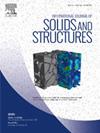Investigation of fracture behaviour of a complex interface crack using a modified interaction energy integral method under thermal shock loading
IF 3.4
3区 工程技术
Q1 MECHANICS
International Journal of Solids and Structures
Pub Date : 2025-03-05
DOI:10.1016/j.ijsolstr.2025.113317
引用次数: 0
Abstract
The fracture behavior of advanced materials with complex interfaces is a critical concern in material design and manufacture. In this article, a novel method is proposed to capture fracture parameters of a crack in multiphase materials with complex interfaces under thermal shock loading. With the help of the designed auxiliary fields, the interaction energy integral method (IEIM), which is complicated by both the complex interface structure and the thermal shock loading, is simplified, making it applicable to various types of multiphase materials and the thermal shock conditions. Using this method, the crack growth in the complex interface structure of advanced multiphase material under transient, thermal shock loading is investigated. The evolution of the complex thermal stress intensity factors (CTSIFs) of mixed-mode around the interface crack tip is presented during the process of thermal shock loading, and the corresponding influence caused by the complex interface is examined from multiple perspectives. First, the relationship between the transient values of each CTSIF and the corresponding crack length is established during the thermal shock process. Both K1 and K2 exhibit distinct changes when the crack reaches the interface, which intersects its propagation path in all three multiphase materials. Next, from the variation of the peak values of each CTSIF, a potential well and a sharp variation in the slope of K2 are identified in the process of thermal shock, which are attributed to the presence of the complex interface structure. These founds suggest that specific interface types within the complex interface structure can influence the CTSIF of the interface crack under thermal shock. Additionally, the strain energy release rate is computed and analysed. Based on its variation, the process of the interface crack growth under thermal shock is classified into the unstable and the stable growth. Those findings, along with the proposed IEIM provide valuable insights for the design, evaluation, and engineering applications of complex thermal interfaces in advanced materials.
在热冲击加载下使用修正的相互作用能量积分法研究复杂界面裂纹的断裂行为
本文章由计算机程序翻译,如有差异,请以英文原文为准。
求助全文
约1分钟内获得全文
求助全文
来源期刊
CiteScore
6.70
自引率
8.30%
发文量
405
审稿时长
70 days
期刊介绍:
The International Journal of Solids and Structures has as its objective the publication and dissemination of original research in Mechanics of Solids and Structures as a field of Applied Science and Engineering. It fosters thus the exchange of ideas among workers in different parts of the world and also among workers who emphasize different aspects of the foundations and applications of the field.
Standing as it does at the cross-roads of Materials Science, Life Sciences, Mathematics, Physics and Engineering Design, the Mechanics of Solids and Structures is experiencing considerable growth as a result of recent technological advances. The Journal, by providing an international medium of communication, is encouraging this growth and is encompassing all aspects of the field from the more classical problems of structural analysis to mechanics of solids continually interacting with other media and including fracture, flow, wave propagation, heat transfer, thermal effects in solids, optimum design methods, model analysis, structural topology and numerical techniques. Interest extends to both inorganic and organic solids and structures.

 求助内容:
求助内容: 应助结果提醒方式:
应助结果提醒方式:


